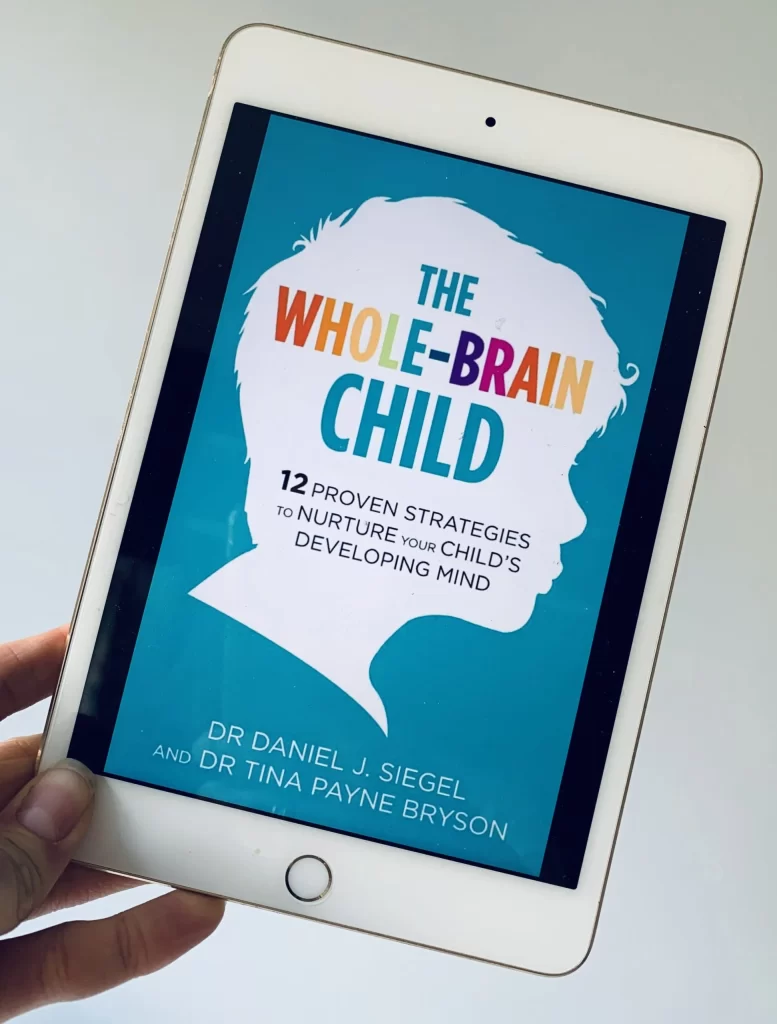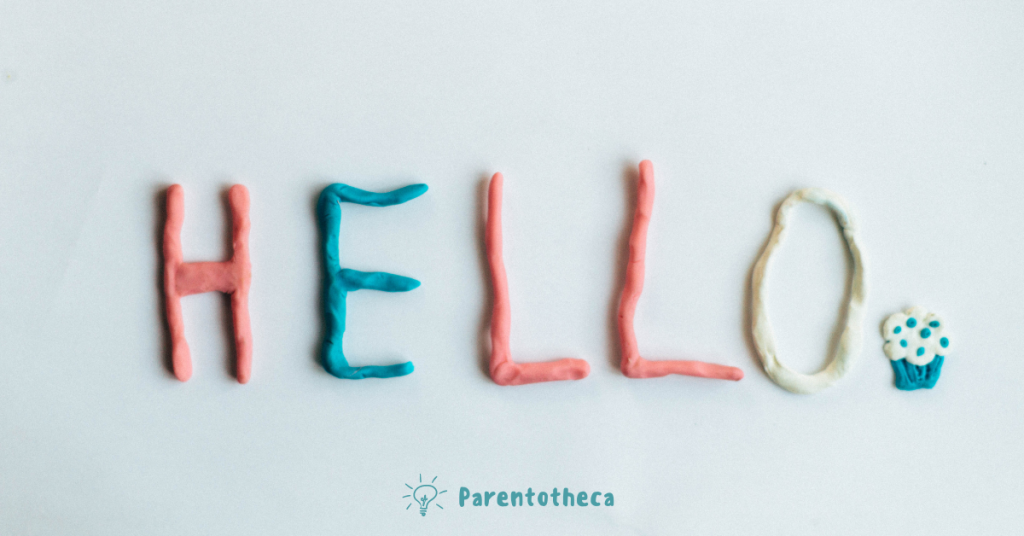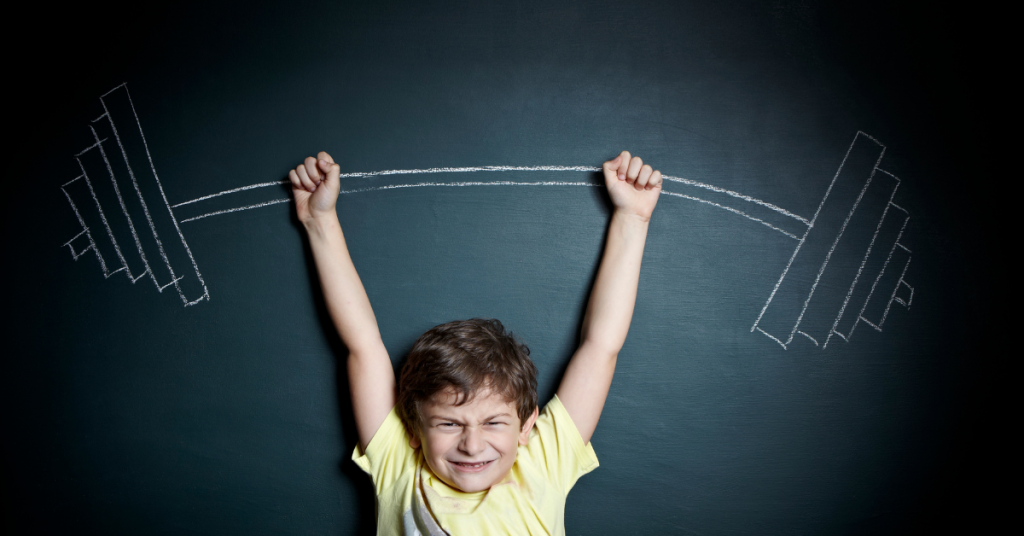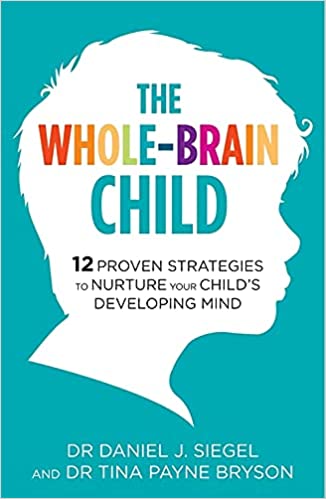 The Whole-Brain Child
The Whole-Brain Child
12 proven strategies to nurture your child’s developing mind
Dr Tina Payne Bryson and Dr Daniel Siegel
Robinson; First Edition (16 Aug. 2012)
About the authors:
Daniel J. Siegel, M.D., received his medical degree from Harvard University and is currently a clinical professor of psychiatry at the UCLA School of Medicine and the founding co-director of the Mindful Awareness Research Center at UCLA. An educator, he is a Distinguished Fellow of the American Psychiatric Association and recipient of several honorary fellowships. The executive director of the Mindsight Institute, the medical director of the LifeSpan Learning Institute and on the advisory board of the Blue School in New York City, which has built its curriculum around Siegel’s Mindsight approach. His psychotherapy practice includes children, adolescents, adults, couples, and families.
Tina Payne Bryson, PhD, is the Founder and Executive Director of The Center for Connection, a keynote speaker and a mom of three boys. She conducts workshops for parents, educators, and clinicians worldwide, and she frequently consults with schools, businesses, and other organizations.
About the book:
This book is a must-read for every parent. Here neuroscientist Daniel J. Siegel and parenting expert Tina Payne Bryson explain the science of how a child’s (and our own) brain is wired and how it matures. But most importantly, they share 12 practical strategies on integrating different parts of your child’s brain. Complete with clear explanations, age-appropriate strategies for dealing with day-to-day struggles, and illustrations that will help you explain these concepts to your child, The Whole-Brain Child shows you how to cultivate healthy emotional and intellectual development so that your children can lead balanced, meaningful, and connected lives.
Key insights:
“By understanding a few simple and easy-to-master basics about how the brain works, you’ll be able to better understand your child, respond more effectively to difficult situations, and build a foundation for social, emotional, and mental health.”
When you understand how a child’s brain works (and our own as well), parenting may become way much easier.
Our brain determines who we are and what we do. What moulds it? Our experiences. That means that whatever happens in life – the books we read, the discipline we receive, the emotions we feel, etc. – profoundly affects the way our brain develops. So our role as parents is to provide the kinds of experiences that will help our kids develop a resilient, well-integrated brain.
In short, our brain consists of many different parts, and if we want our child to thrive, we need to help him learn how to integrate these parts, so their brain would work in harmony to tackle whatever comes on the way. And that’s what the authors call “whole-brain parenting”.
The Whole-Brain Child is one of those “Why didn’t I read it before?!” books ☺ It is full of science-based strategies on how you can help your child develop the brain to the full potential and thrive in life. Let’s jump to our favourite ideas.
Survive and Thrive
“Take a moment and ask yourself: What do you really want for your children? What qualities do you hope they develop and take into their adult lives? Most likely, you want them to be happy, independent, and successful. You want them to enjoy fulfilling relationships and live a life full of meaning and purpose. Now think about what percentage of your time you spend intentionally developing these qualities in your children. If you’re like most parents, you worry that you spend too much time just trying to get through the day (and sometimes the next five minutes) and not enough time creating experiences that help your children thrive, both today and in the future. […]
If any of this sound familiar, we’ve got great news for you: the moments you are just trying to survive are actually opportunities to help your child thrive. At times you may feel that the loving, important moments (like having a meaningful conversation about compassion or character) are separate from the patenting challenges (like fighting another homework battle or dealing with another meltdown). But they are not separate at all. When your child is disrespectful and talks back to you, when you are asked to come in for a meeting with a principal, when you find crayon scribbles all over your wall: these are survive moments, no question about it. But at the same time, they are opportunities – even gifts – because a survive moment is also a thrive moment, where the important, meaningful work of parenting takes place.”
That is simply brilliant! Our parenting life is full of day-to-day challenges, and they are priceless for our kids’ development.
Siegel and Bryson tell us that if we look at these everyday parenting challenges from the neuroscience perspective, they all come from a lack of integration within our child’s brain. That’s simply because our child’s brain is still developing, and different parts of it don’t have established connections yet.
Therefore, if we use these day-to-day “survive moments” wisely, we can influence how well our child’s brain grows toward integration:
“First, you can develop the diverse elements of your child’s brain by offering opportunities to exercise them. Second, you can facilitate integration so that the separate parts become better connected and work together in powerful ways”.
The brain is like a muscle, and it’s better to train it right from childhood. Note: remember about the neuroplasticity – you can change your brain as well!
Question for you: what are your usual “survive” moments? Let’s look at some ideas on how you can turn them into the “thrive” ones ☺
Children’s brains mirror their parents’ brains
“As children develop, their brains “mirror” their parent’s brain. In other words, the parent’s own growth and development, or lack of those, impact the child’s brain. As parents become more aware and more emotionally healthy, their children reap the rewards and move toward health as well. That means that integrating and cultivating your own brain is one of the most loving and generous gifts you can give your children”.
If you want your kids to thrive, start working on your own brain first. That’s the starting point. And a win-win approach. How? The 12 whole-brain strategies also work for adults (more on that below).
Use parenting as an opportunity to grow and become the best role model for your children.
12 Whole-brain child strategies
“The powerful and practical approach of integration enables us to see the many ways in which our children – or we ourselves – experience chaos and rigidity because integration has been blocked. When we become aware of this idea, we can then create and carry out strategies that promote integration in our kids’ lives and in our own. These are the day-to-day whole-brain strategies we’ll explore in each of the following chapters”.
If our parts of the brain are integrated, we feel harmony. If the integration is blocked, we experience chaos and rigidity. So the first step is actually just to become aware of this ☺ and then you can help the “disintegrated” brain to get back to “the river of well-being” with 12 strategies suggested by Siegel and Bryson. We’ll cover just a few of them here, but here you can get a “refrigerator sheet”, where the authors summarised all the techniques.
These strategies are very powerful (even life-changing) and relatively easy to put into practice.
How to surf emotional waves like a pro
“When a child is upset, logic often won’t work until we have responded to the right brain’s emotional needs. We call this emotional connection “attunement”, which is how we connect deeply with another person and allow them to “feel felt”. When a parent and child are tuned in to each other, they experience a sense of joining together.”
Kids can get very emotional or upset about something and get carried away by illogical concerns. Younger kids may explode in a tantrum or even in destructive behaviour. All of these are signals that their right brain gets disconnected from the left one.
In a nutshell, our brain has two hemispheres (or two brains). Our right brain is holistic and nonverbal and specializes in images, emotions, and personal memories. Very young children are right-hemisphere dominant, especially for the first three years of their life. Our left brain is logical, literal, linguistic and linear, and it develops at a slower pace.
So if your child comes to you upset about something that doesn’t make much sense to you, don’t try to fight against the huge waves of emotional flood – words and logical explanation would not work. Instead, you can use the connect and redirect technique, which consists of two steps:
Step 1: connect with the right: appeal to the right brain by acknowledging the child’s feelings. Use nonverbal signals like physical touch, empathetic facial expression, nurturing tone of voice and nonjudgmental listening.
Step 2: redirect with the left: once your child “feels felt”, you can redirect with the left brain through logical explanation and planning, so his left hemisphere would join the conversation.
For example, today, our (almost) six-year-old son looked very grumpy in the morning and totally refused to leave the house without his favourite winter jacket. It was +17C outside, and we were already late for school. And yes, it was his brother’s birthday (guess who got all the attention :).
Obviously, his right brain took over. We knew that if we talk to his left brain straight away, explaining that it’s too warm outside for a winter jacket, our morning will be ruined. We’ve used the “connect and redirect” strategy instead:
- Connected with his right brain: we hugged Max and acknowledged that it might be upsetting that his birthday is still two weeks away.
- Redirected with the left brain: we’ve explained that it’s a warm sunny morning and he might feel more comfortable in a jumper. And we asked if he could think about how he would like to celebrate his birthday.
Worked magically 🙂
Authors note, that this strategy may not work all the time though, some meltdowns may be pretty emotional and a child may “pass the point of no return”. But the whole point is that logic doesn’t work when a child is emotionally flooded. Wait for him to calm down and then connect and redirect.
Amigdala hijack – how to integrate upstairs and downstairs brain
“One of the most important skills we can teach our kids is to make good decisions in high emotion situations […] We want them to pause before acting, to consider consequences, to think about the feelings of others, to make ethical and moral judgements. Sometimes they come through with the kind of behaviour that makes us proud. And sometimes they don’t.”
Siegel and Bryson explain the concept of a “downstairs” and “upstairs” brain and basically give an overview of the science behind our emotions.
In a nutshell, our lower, more primitive brain is responsible for basic functions (like blinking and breathing), innate reactions and impulses (fight and flight) and for strong emotions (like anger and fear). When this brain controls your behaviour, you may throw a temper tantrum just like your child or do something impulsively foolish.
Our upstairs brain (cerebral cortex) is more evolved and sophisticated, and it balances out the downstairs brain. It can give you a better perspective of the world as it is responsible for thinking, imagining, planning and self-understanding. When this part of the brain is properly functioning, our child will demonstrate the most important characteristics of a mature human being (like empathy, sound decision-making and planning, control over emotions, etc.).
As you can guess, the upper brain develops at a slower pace (up to mid-twenties), so in young children, the primitive part is dominant, making it easier for it to take control over the upper brain. One specific part of the lower brain, the amygdala, processes emotions and can quickly hijack a person’s upper brain, especially a child’s, flooding him with stress hormones and making him act before he thinks.
The authors give us a strategy on how to integrate upstairs and downstairs brain in case of a tantrum/misbehaviour (“Engage, don’t enrage: appealing to the upstairs brain” ):
- use the “connect and redirect” strategy to connect with the child and calm him down
- engage his upper brain by asking what’s happening and if a problem caused his anger. Ask your child for a solution to the problem (“come up with a solution that works for both of us” & “convince me”)
Dr Siegel and Dr Bryson also remind us that the upper brain is like a muscle, and we need to help our kids to train it, so it develops, gets stronger, and performs better. They give two more strategies on how to do it – check out the book for more.
One more important point here – parenting is not easy, and sometimes our own amygdala takes over our upper brain, so we behave impulsively towards our kids (like yelling and spanking – something we regret later on). So it’s important to “use our own mental staircase” to integrate two parts of our brain. Next time you feel you are losing control and are close to “flipping your lid”, take a big breath and do this:
- do no harm – “close your mouth and avoid saying something you’ll regret” and put your hands behind your back
- remove yourself from the situation and collect yourself – you can tell your child that you need to come down, so he doesn’t feel rejected
- repair (quickly) – “reconnect with your child as soon as you are calm and feeling more in control of yourself”. If there was some “emotional harm”, – apologize and take responsibility for your actions.
The third part is CRUCIAL, so you don’t harm your child’s self-esteem (in “Your competent child” Jasper Juul shares the same idea).
Again, lead by example and demonstrate self-regulation ☺ Little eyes are watching!
Mindsight and the wheel of awareness
“It’s very exciting to understand (and to teach our kids) that we can use our minds to control our lives. By directing our attention, we can go from being influenced by factors within and around us to influencing them. When we become aware of the multitude of changing emotions and forces at work around us and within us, we can acknowledge them and even embrace them as parts of ourselves – but we don’t have to allow them to bully us or define us. We can shift our focus to other rim points on the wheel of awareness, so that we are no longer victims of forces seemingly beyond our control, but active participants in the process of deciding and affecting how we think and feel.”
Our mind is our superpower – we can use it to control our lives! That’s all about living consciously.
Mindsight is a very famous concept developed by Dr Siegel (check out his book Mindsight – notes are coming soon). It is basically about “understanding our own mind as well as understanding the mind of another”.
Want your child to develop emotional intelligence, growth mindset and healthy self-esteem – help him develop mindsight from early childhood and teach him that he can choose where to place his focus. Dr Siegel came up with this simple model (The Wheel of Awareness), which you can teach to your kids:
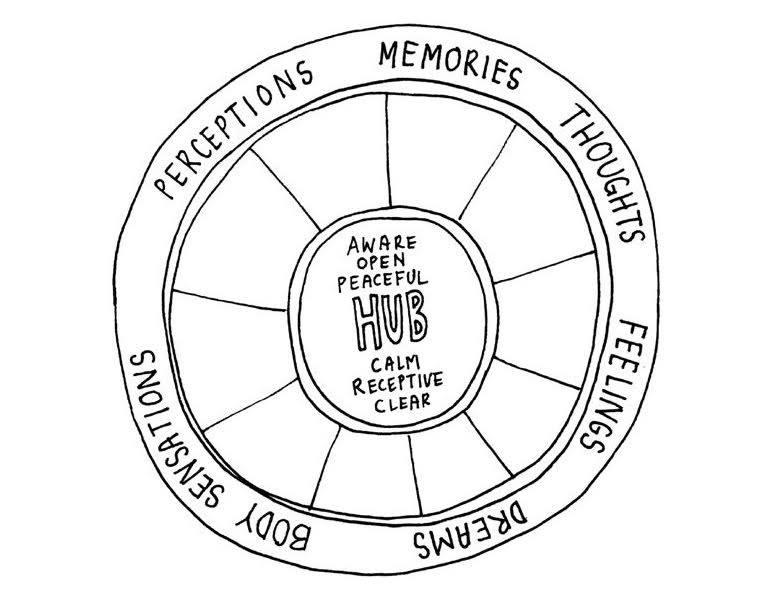
He writes:
“Our mind can be pictured as a bicycle wheel, with a hub at the center and spokes radiating toward the outer rim. The rim represents anything we can pay attention to or become aware of: our thoughts and feelings, our dreams and desires, our memories, our perceptions of the outside world, and the sensations from our body.
The hub is an inner place of the mind from which we become aware of all that’s happening around and within us. It’s basically our prefrontal cortex, which you’ll remember helped to integrate the whole brain. The hub represents part of what’s called the executive brain, because it’s from this place we make our best decisions; it’s also the part of the brain that allows us to connect deeply to others and to ourselves. Our awareness resides in the hub, and from here we can focus on the various points on the rim of our wheel.”
Whatever happens in our mind (our feelings, thoughts, perceptions, etc) is: a) temporary, b) does not define who we are. Moreover, we can choose where to focus our attention. How? By becoming aware of our rim points on our wheel of awareness, and understanding that we don’t have to be victims of our sensations, feelings, images and thoughts – we can always go back to our hub and decide how we think and feel about our experiences.
So whenever you see that your child got stuck on one point of his wheel of awareness and loses sight of the many parts of himself, try these three strategies:
1) explain that feelings come and go – the average emotion lasts only 90 (!!!) seconds. He would not feel sad or angry forever 🙂 “The more kids understand that feelings come and go, the less they’ll get stuck on the rim of their wheel and the more they’ll be able to live life and make decisions from their hub”.
2) help your child to become aware of his SIFT: the bodily sensations, images, feelings and thoughts that he experiences. To do so, ask him about every one of them to show that they all matter: “By teaching our children to SIFT though the activity of their mind, we can help them recognize the different rim points at work within them, and help them gain more insight and control in their lives”.
3) exercise mindsight: teach your child to “return to the hub” to calm himself down and focus his attention at will. For example, by focusing on his breath and visualizing a place where he feels safe and happy. Technically, teach your child a basic meditation technique 🙂
Action steps for you:
- Help your children develop Mindsight and teach them about The Wheel of Awareness.
- When your child is flooded with negative emotions (e.g. upset, angry), try to connect with his right brain first (acknowledge the feelings, give a hug, talk to him gently) and then redirect to the left brain (e.g. come up with solution, give reasons, etc.)
- Embrace the fact that your child’s brain is still “work in progress” and help him integrate different parts of the brain in day-to-day activities. Think about your “surviving moments” (tantrums, child’s illogical concerns, fights between siblings, etc.) – how can you turn them into the “thriving moments”?
Quotes from the book:






